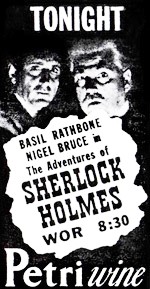
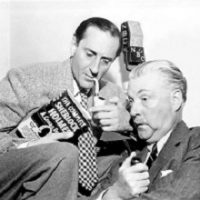 The New Adventures of Sherlock Holmes (1939-47) aired “The Haunting of Sherlock Holmes” on May 20, 1946. Our last episode of Sherlock Holmes appeared in February of 2020, more than a year go, so I thought it high time for another one. During this incarnation of Sherlock Holmes on radio (the first coming in the early 1930s and the last running to 1959), Basil Rathbone (1892-1967) and Nigel Bruce (1895-1953) reprised their Universal studio film roles of Sherlock Holmes and Dr. Watson for close to 220 episodes. Afraid of being typecast–and following the cancellation of further Holmes films–Rathbone wanted out of his radio role. Though the show’s sponsor at the time, Petri Wines, offered him a generous bump in compensation if he would continue, Rathbone declined. Following his final episode as Holmes at the end of May 1946, the Holmes character was played by popular British actor Tom Conway (who was an excellent Holmes), with Bruce staying on until the series end in 1947. For several years during this series (including this episode) scripts were written by the team of future F&SF co-founder Anthony Boucher, and Denis Green. Boucher, a diehard Holmes fan, would pen the outlines of scripts and Green would supply the details. They worked well together and the show flourished.
The New Adventures of Sherlock Holmes (1939-47) aired “The Haunting of Sherlock Holmes” on May 20, 1946. Our last episode of Sherlock Holmes appeared in February of 2020, more than a year go, so I thought it high time for another one. During this incarnation of Sherlock Holmes on radio (the first coming in the early 1930s and the last running to 1959), Basil Rathbone (1892-1967) and Nigel Bruce (1895-1953) reprised their Universal studio film roles of Sherlock Holmes and Dr. Watson for close to 220 episodes. Afraid of being typecast–and following the cancellation of further Holmes films–Rathbone wanted out of his radio role. Though the show’s sponsor at the time, Petri Wines, offered him a generous bump in compensation if he would continue, Rathbone declined. Following his final episode as Holmes at the end of May 1946, the Holmes character was played by popular British actor Tom Conway (who was an excellent Holmes), with Bruce staying on until the series end in 1947. For several years during this series (including this episode) scripts were written by the team of future F&SF co-founder Anthony Boucher, and Denis Green. Boucher, a diehard Holmes fan, would pen the outlines of scripts and Green would supply the details. They worked well together and the show flourished.
 Since 130 years have passed since the first story of Sherlock Holmes and Dr. John Watson appeared in Beeton’s Christmas Annual magazine for December 1887 (A Study in Scarlet), much has been written, filmed, or dramatized of the most famous sleuth on the planet. In fact, the Wikipedia page devoted to Holmes, states that the Guinness Book of World Records’ lists the Holmes character as “the ‘most portrayed movie character in history’ with more than 70 actors playing the part in over 200 films.” And while hardly all inclusive, Wikipedia notes that those writing Holmes pastiches number the likes of Anthony Burgess, Neil Gaiman, Dorothy B. Hughes, Stephen King, Tanith Lee, A. A. Milne, and P. G. Wodehouse–to which I will add Manly Wade Wellman, Philip Jose Farmer, James Lovegrove, George Mann, Kim Newman, and Fred Saberhagen. It’s a sure bet there have been many others of genre interest over the years who have tried their hand at a Sherlock Holmes novel as well.
Since 130 years have passed since the first story of Sherlock Holmes and Dr. John Watson appeared in Beeton’s Christmas Annual magazine for December 1887 (A Study in Scarlet), much has been written, filmed, or dramatized of the most famous sleuth on the planet. In fact, the Wikipedia page devoted to Holmes, states that the Guinness Book of World Records’ lists the Holmes character as “the ‘most portrayed movie character in history’ with more than 70 actors playing the part in over 200 films.” And while hardly all inclusive, Wikipedia notes that those writing Holmes pastiches number the likes of Anthony Burgess, Neil Gaiman, Dorothy B. Hughes, Stephen King, Tanith Lee, A. A. Milne, and P. G. Wodehouse–to which I will add Manly Wade Wellman, Philip Jose Farmer, James Lovegrove, George Mann, Kim Newman, and Fred Saberhagen. It’s a sure bet there have been many others of genre interest over the years who have tried their hand at a Sherlock Holmes novel as well.
For the story of how Sherlock Holmes first came to radio, and who was responsible for it, read the introduction to “The Adventure of the Devil’s Foot” here, and discover why all Holmes fans are indebted to a most remarkable woman.
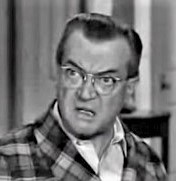 As to this episode, Nigel Bruce is temporarily replaced by Joseph Kearns (1907-1962, photo at left). Kearns does a superb job as stand in, and was one of those rare voice actors who played many a role in classic radio shows, from drama to comedy. I didn’t notice that Kearns was filling in for Bruce until it was mentioned at the end of the program. Kearns is probably best known today for playing the original Mr. Wilson, the grouchy next door neighbor to Dennis in the Dennis the Menace (1959-63) TV program. Long before his TV work, however, Kearns was one of the most ubiquitous actors on radio, appearing in literally dozens of shows and hundreds of episodes of some of the most popular programs, among which include but are not limited to: The Whistler, Suspense, The Adventures of Sam Spade, The Mel Blanc Show, and even Sherlock Holmes’ arch enemy Dr. Moriarity. And of course in this episode he doubled brilliantly for Nigel Bruce as Dr. Watson. Kearns had one of those special talents that could flawlessly imitate dialects and the vocal mannerisms and inflections of almost any character, thus it was no wonder he had steady radio work for more than twenty years as the cornerstone of his income, while pursuing his film and later, TV work. Appearing in maybe a dozen films in low-key roles, perhaps the most famous is his role as Lloyd Burke in 1959’s Anatomy of a Murder (starring James Stewart, Lee Remick, Ben Gazzara, and George C. Scott). He loved to cook and read, and one of his favorite pastimes was playing the organ. He never married or had children. He died of a cerebral hemorrhage on February 17, 1962 after filming the 100th episode of Dennis the Menace.
As to this episode, Nigel Bruce is temporarily replaced by Joseph Kearns (1907-1962, photo at left). Kearns does a superb job as stand in, and was one of those rare voice actors who played many a role in classic radio shows, from drama to comedy. I didn’t notice that Kearns was filling in for Bruce until it was mentioned at the end of the program. Kearns is probably best known today for playing the original Mr. Wilson, the grouchy next door neighbor to Dennis in the Dennis the Menace (1959-63) TV program. Long before his TV work, however, Kearns was one of the most ubiquitous actors on radio, appearing in literally dozens of shows and hundreds of episodes of some of the most popular programs, among which include but are not limited to: The Whistler, Suspense, The Adventures of Sam Spade, The Mel Blanc Show, and even Sherlock Holmes’ arch enemy Dr. Moriarity. And of course in this episode he doubled brilliantly for Nigel Bruce as Dr. Watson. Kearns had one of those special talents that could flawlessly imitate dialects and the vocal mannerisms and inflections of almost any character, thus it was no wonder he had steady radio work for more than twenty years as the cornerstone of his income, while pursuing his film and later, TV work. Appearing in maybe a dozen films in low-key roles, perhaps the most famous is his role as Lloyd Burke in 1959’s Anatomy of a Murder (starring James Stewart, Lee Remick, Ben Gazzara, and George C. Scott). He loved to cook and read, and one of his favorite pastimes was playing the organ. He never married or had children. He died of a cerebral hemorrhage on February 17, 1962 after filming the 100th episode of Dennis the Menace.
“The Haunting of Sherlock Holmes” opens as the world’s greatest sleuth and Dr. Watson are on holiday in Europe, attending the opera. The star opera singer, following a splendid performance, is outed as a spy and sentenced to death by local law. From here on in hardly a single thing is as it seems, as Anthony Boucher and Denis Green have turned in a dandy mystery indeed, one that has Dr. Watson exclaiming at one point that it surely must involve the supernatural.
On a final note, this week’s OTR episode is a numerical landmark of sorts, a number I thought we would never reach when this humble feature’s first episode was posted in June of 2009. There have been some weeks containing several short episodes or even two full-length episodes, but this episode marks the 600th individual posting so I thought I would make note of the occasion by finding something special to showcase. So why a Sherlock Holmes episode, you ask? Elementary, dear listener, elementary. As noted above, “the Guinness Book of World Records’ lists the Holmes character as “the ‘most portrayed movie character in history’ with more than 70 actors playing the part in over 200 films.” And the Holmes novel pastiches number nearly as many as the films. We celebrate these milestones (that of Sherlock Holmes, and ours) by bringing you this week’s Sherlock Holmes adventure.
Play Time: 30:43
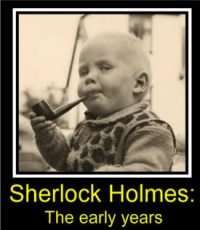
{Though this Sherlock Holmes episode aired on a Monday evening of a school week, it failed to deter the neighborhood gang from heading straight for the corner newsstand after school the next day to enrich their growing stacks of mystery/detective magazines. Street & Smith’s Detective Story Magazine (1915-53) was a long-standing favorite (being the first pulp magazine totally devoted to detective fiction), and along with its regular range of detective stories it actually incorporated and continued the final installment of a Nick Carter serial after that sleuth’s magazine folded. It was a monthly in 1946. Dime Detective (1931-53) also supplied reliable, action-filled detective fare for its readership, a faithful audience that had followed the magazine since its heyday in the 1930s. It too was a monthly in 1946. The Phantom Detective (1933-53) was consciously tailored to be a rival to Street & Smith’s popular The Shadow magazine, hopefully to cash in on the Shadow’s winning formula. It seemed to have worked, for though The Phantom Detective was only a bi-monthly for half of its 20+ year run (the first half was monthly), it nevertheless holds the record for being the longest running single character pulp magazine in history. It managed 5 issues in 1946. Of interest is that regardless of when each of these magazines debuted, they each met their demise in 1953, foreshadowing the pulp magazine industry’s death in 1957 when American News Company succumbed to the 5-year anti-trust suit brought by the government in 1952, and closed shop overnight, leaving many magazines both large and small looking for a different distributor or folding altogether. The rise of the cheap paperback format and the new medium of television didn’t help, either.]
[Left: Detective Story, May 1946 – Center: Dime Detective, May 1946 – Right: Phantom Detective, June 1946]
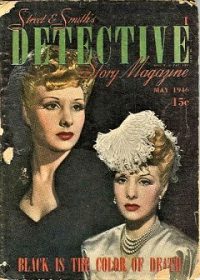
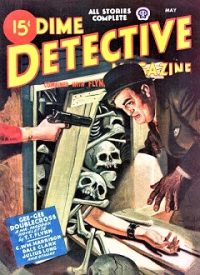
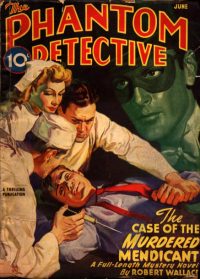
To view the entire list of weekly Old Time Radio episodes at Tangent Online, click here.